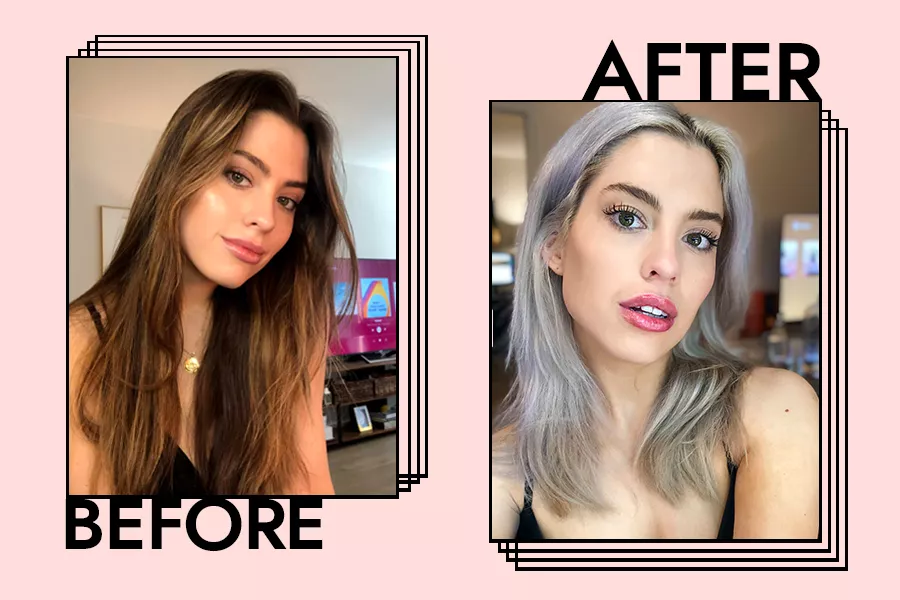
In This Article
Things to Consider
What You Need
Step-by-Step
Post Care
Well, I did it. I bleached my hair at home without any damage. Transforming my hair from chestnut brown to Khaleesi silver took a lot of research, dedication, and, frankly, risk-taking than is conveyable in my group chats.
In light of this fact, I’ve delineated the exact precautions, products, and step-by-step process I used to bleach and tone my hair silver at home. Huge disclaimer: I am by no means a professional colorist. Moreover, the professional colorists I did speak to were decidedly opposed to my DIY-silver-shenanigans (the overarching sentiment: “go to a pro!”) but they were kind enough to spill some of their secrets nonetheless.
If—against your better judgment and the advice of every colorist ever—you are dead-set on going silver at home grab a notepad and proceed—with utmost caution. But before we start, a few things you must read up on before you bleach and tone.
Recognize the risks
While there are bleach-free formulas that allow you to temporarily switch your color on a whim, going from brown to silver in a permanent way “absolutely” requires bleach, notes WELLA Chief Blonding Officer, Zach Mesquit. Often referred to as “lightener,” bleach is a powerful chemical that can have a dark side. "The bleaching process can completely ruin your hair beyond repair when used incorrectly or too quickly,” Mesquit warns. This is because the mechanism by which bleach works to lighten your hair is inherently damaging. “Bleach literally breaks apart the proteins in your hair,” explains Aura Friedman, celebrity colorist and creative director at Sally Hershberger Salon in NYC. “[This] makes your hair extremely weak,” she adds, and “ultimately leads to breakage, as well as frizz and dryness.”
For me, it took watching a few dozen “bleach fail” videos and reading a handful of horror stories to fully appreciate the risks of playing colorist at home. At worst, bleach can melt your hair off; at best, it inflicts mild damage—which, though imperceptible to the naked eye, still inevitably exists (you’d see it under a microscope). Bottom line: bleach damages your hair to some degree. Ultimately, the goal is to inflict the least degree of damage possible. Trained professionals are, well, pros, at mitigating bleach damage—but as someone who’d never touched the stuff, I had a lot to study before I stocked up on supplies.
Do your research
At the beginning of stay-at-home orders, hair color research became a hobby; one that replaced the gaps in my calendar I’d once filled with social activities. I’d stare unblinkingly at my screen until my eyes hurt; if I woke up and couldn’t fall back asleep, I’d return to my laptop and research some more. Pinterest, Reddit, Youtube, and buuk.top became my go-to sources for hair color how-tos. Even now, I still spend significant time trying to learn more about beaching, toning, and hair color in general. Of course, no amount of bleary-eyed research can match the knowledge and skill of a professional—and in my case, my lack of artistry shows if you look really closely at my roots. After all, colorists spend significant time learning to perfect the many nuances of their craft.
Understand your timeline
Another time-related consideration: depending on how dark your hair is, to begin with, it could take weeks (at least) to months (more likely) to safely reach the pale silver color you’re going for. The reason being, that your hair needs time to recover between bleach sessions.
I bleached my hair a total of three times over the course of a month and a half. Each time, it turned a new shade of brassy—orange to orange-yellow, orange-yellow to pale yellow—and I’d be lying if I said I didn’t feel a little self-conscious during these transitional phases. Nowhere is the adage, “patience is a virtue” more apparent than with hair bleaching at home.
Understand your hairs “levels”
Before I started going down various hair-color-wormholes, I didn’t fully understand why I couldn’t simply slap silver dye over my brown hair and call it a day. The reason, I’ve learned, is rooted in hairs’ natural color pigments, and best explained by something called the level system.
Simply put, the level system is a scale colorists use to reference how light or dark someone’s hair is. The standard level system goes from 1-10 (though I have seen 1-12), with 1 being black, and 10 being an extremely pale yellow. (Note: “level” is different from tone; more on why later.) Determining where your natural hair color falls on the level system (I’m around a level 4) can provide a reference point for how light your hair might “lift” in a single bleaching session. You can then use this info to gauge how many bleaching sessions you’ll need.
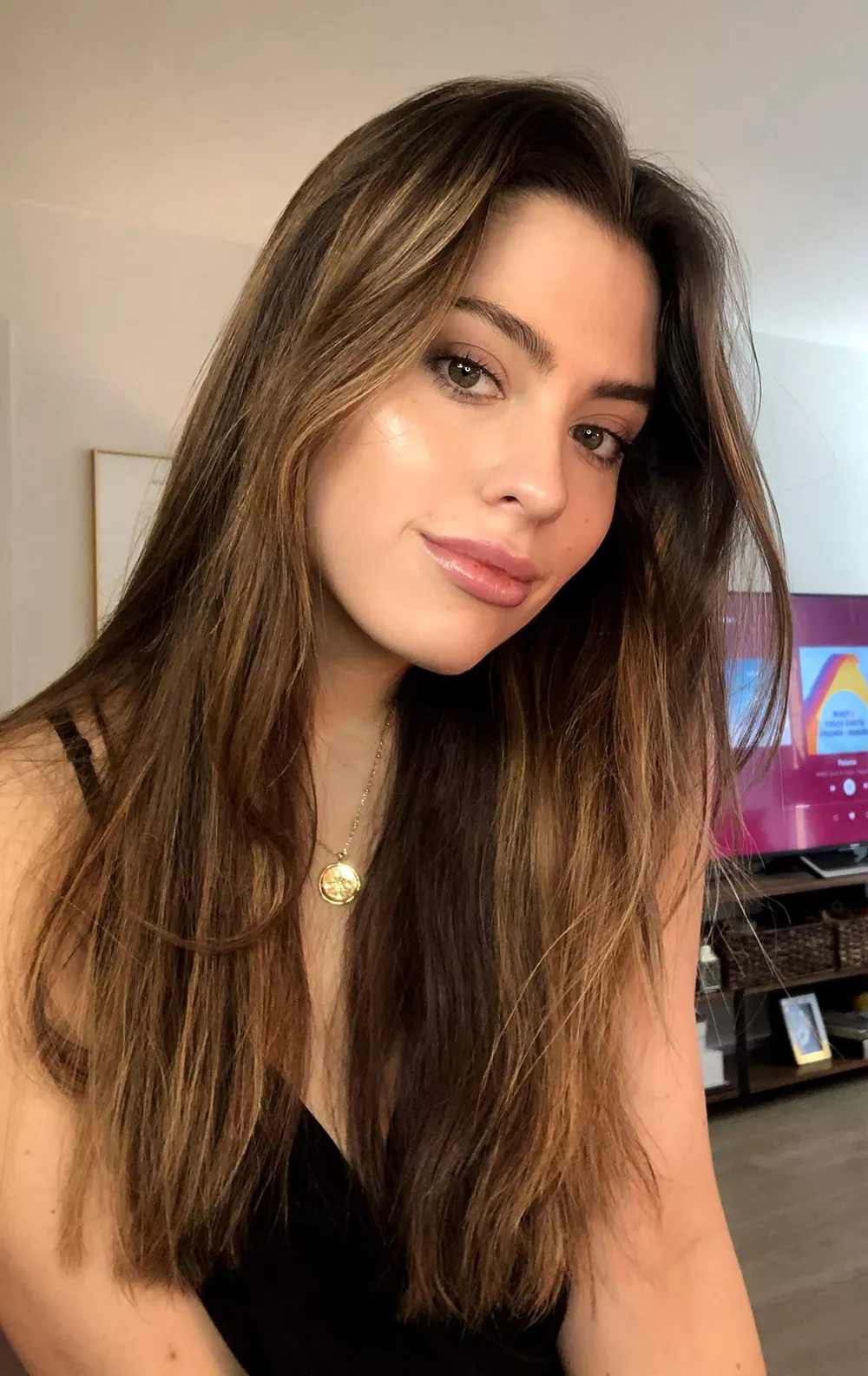
Sophie Wirt
My Natural Hair Color
Your level is determined by the amount of natural pigment, aka melanin, each strand contains. I’ll spare you the chem class flashbacks, but basically, bleach, when paired with peroxide, opens the hair cuticle (aka your hairs outer layer) and “lifts” these pigments out. The darker your hair, the more numerous your pigments; the more numerous your pigments, the more you’ll have to “lift” those pigments to lighten your hair. "You cannot achieve silver-colored hair unless the hair is lifted to at least a very light level 9— ideally you want a level 10/platinum,” notes Mesquit. (For reference, many people compare levels 9/10 to the color of the inside of a banana peel). Only once you’ve reached this “lifted,” de-pigmented state can you go in and add pale silver pigment—usually via toner.
One common analogy that illustrates why you need to “lift” before you deposit a light color into the hair: Imagine using a yellow highlighter on a dark (black/brown) piece of paper. Doesn’t show up so well, huh? Now, imagine using that yellow highlighter on a piece of pale printer paper—voilà! Similar to that yellow highlighter, toners in the silvery-platinum-blonde families cannot simply replace dark pigment without bleaching it first. That underlying pigment needs to be removed in order for the silver to show up.
It’s also worth noting that peroxide, aka “developer,” is a necessary component of the bleaching process. Without it, the bleach cannot lift color pigments. However, it is important to note that peroxide developer comes in different strengths.
Peroxide strength is measured in what colorists call “volumes.” Peroxide volumes typically range from 10-40, with 10 being the least powerful in terms of “lift” and damage potential, and 40 delivering the most “lift” and crazy-risky damage potential. Both Mesquit and Walker advise steering clear of anything higher than 20 volume. Admittedly, I used 30 volume developer the first two times I bleached; it worked, but I can’t help but wonder how much healthier my hair would look now if I’d used 20 all along.
Understand tone
While “level” strictly refers to how light or dark your hair is, “tone” refers to nuances—e.g. warmth, coolness, ashiness—within each level. Tone is a complex concept to grasp unless you’re a professional who has studied color theory, but here’s how I think of it: a cool-toned blonde (à la Gwen Stefani) and warm blonde (like Gigi Hadid) can be within the same “level,” but tone gives off drastically different effects.
I knew I wanted an ashy, cool-toned pale blonde, but, frankly, I hadn’t expected my hair to turn straight-up silver-gray. Luckily, I love my color now—but the initial reveal had me panicking and regretting the DIY thing. Even Mesquit, one of the most renowned colorists in the silver-sphere, says toner comes with some degree of unpredictability. “Everyone’s hair will grab a little different,” he explains, “[so] there’s no magic formula when it comes to toner.” Not to mention, “silver is one of the trickiest colors to get right; even the slightest change to the [toner] formula will affect the finished result.” For reference: this is the color I wanted; below is the color I got.

Sophie Wirt
To further complicate things, “People all describe silver differently,” Mesquit notes. “Typically, a lighter silver will be violet-based, and darker will be more blue-based.” He also says you can mix toners, but again, this is the kind of thing best left to a pro unless you’re willing to experiment. The good news (or bad news, depending on whether you like your toner results): Toners tend to fade over time. For me, my ultra-gray hair became a silvery platinum after about five washes. Between washes, I absolutely swear by this mask for keeping my color ultra-gray and banishing yellow tones.
Still with me? Excellent. Without further ado, a step-by-step guide to how I bleached my hair from level 4-ish brown to level 8/9-ish silver.
Supplies Youll Need
Unlike the neatly-packaged, all-in-one box dye kits sold at drugstores, bleaching and toning accoutrements often come piecemeal—and, since bleaching has very little room for error, it’s extra important to ensure you have everything you need before you start. The first time I bleached my hair, it took a week or so to gather all of my supplies (shipping proved spotty from certain vendors; plus, I overlooked some items I later realized I needed). Here’s a comprehensive list of the products I use to bleach, tone, and strengthen my hair, plus a few picks from the pros for good measure.
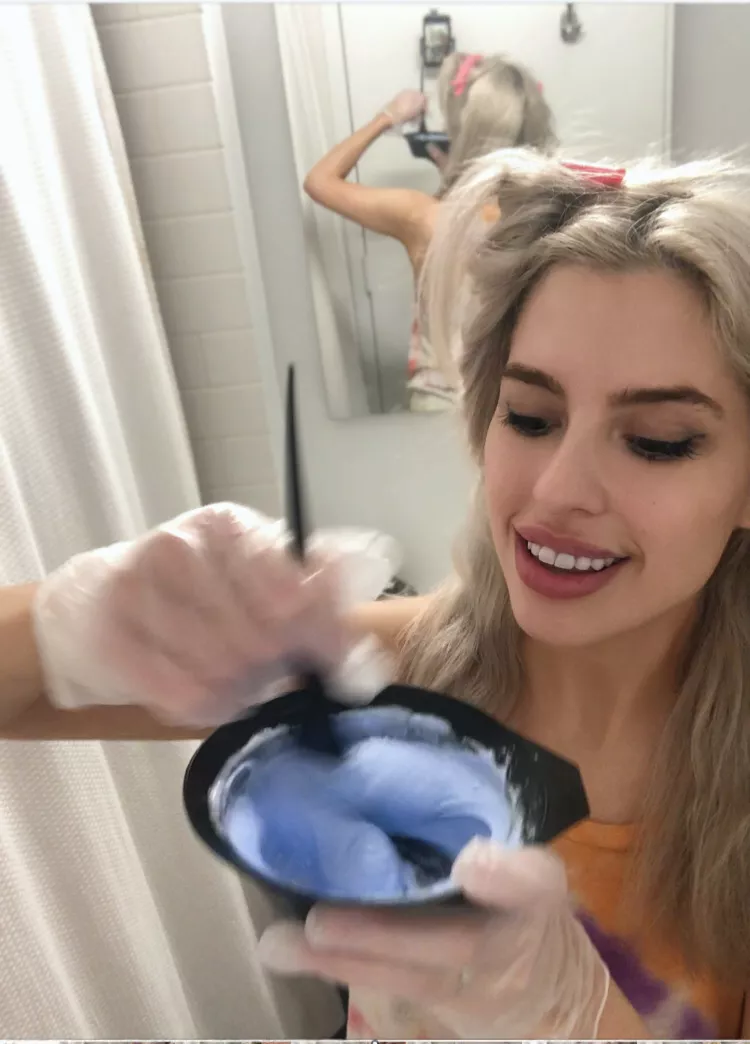
Sophie Wirt
Supplies for bleaching:
Bleach: I use Schwarzkopf Blondme Bond Enforcing Premium Lightener 9+ ($28), which is infused with bond-strengtheners to mitigate damage. Pro picks: Wella Professionals Blondor, Redken Flash Lift.Peroxide developer: I use Schwarzkopf Blondme Premium Care Developer ($18).Plastic mixing bowl: I like to have two on hand; one for bleach, one for toner.
Large applicator brush:Preferably with a pointy tip for sectioning.
Rubber gloves
Sectioning clips
If you’re buying professional products online, make sure you’re using a reputable source. I buy most of my supplies from Amazon, but only if the product has overwhelmingly positive reviews.
Supplies for toning your hair silver
Silver toner:I use Redken EQ Gloss in 09T and 09P (equal parts) or Wella T-18. Pro picks: Wella Color Touch (1.9%/6vol), Wella T-18 (10 or 20vol)Peroxide developer:I use Schwarzkopf 20 vol. Pro picks: Wella 10 or 20 vol Redken’s Shades EQ processing solution, 6vol
Optional, but highly recommended:
Plastic shower caps (one for bleaching, one for toning): These disposable caps from Amazon contain 100 per pack—you’ll never run out!Two large mirrors: Positioned in a way that allows you to clearly see the back of your head (a friend, partner, or willing family member will also do).A gentle microfiber towel:I use Aquis Original Hair Towel ($21).
Supplies for strengthening and aftercare
Protein and/or moisture treatments:I use K18, Sachajuan Hair Repair, and Kérastase Blond Absolu Strengthening Conditioner. Pros use: K18, Olaplex Nº. 3, Redken PH Bonder.
Now that you have your supplies, its time to bleach.
How to Bleach Your Hair At Home
Sophie Wirt
Step 1: Section the hair for bleaching
As with most beauty treatments, prep work is essential for a polished result. Bleach works best on dry hair; preferably dry hair that hasn’t been washed in a while. First and foremost, says Walker, “Make sure to have brushed out your hair—no knots, please!”
Next, it’s time for sectioning. (The first time I bleached my hair, I’d underestimated the importance of partitioning and ended up with some patchy bits as a result; my only saving grace was my boyfriend, who slapped on some bleach in the areas I’d completely overlooked). Sectioning your hair makes the process a lot less overwhelming, more manageable, and increases your chances of even application, Walker explains.
Section your hair into quarters, and use your clips to secure each quarter. Walker breaks it down as follows: “Start [by creating] a center part straight back to the nape of the neck.” This will leave you with two large sections of hair on either side of your head.
To make four sections, use the pointy end of your applicator to split each of the two large sections in half. Then, run the pointy end “from the top of your head to the back of your ears” on either side to create a line that splits each section down the middle. Once you have four sections, clip each section in place. “This will make it much easier to stay clean and not get overwhelmed trying to [bleach everything] all at once,” notes Walker.
Sophie Wirt
Step 2: Mix your bleach and developer
Put on your gloves, ensure surrounding surfaces are covered, and usher any pets, kids, etc. out of the room to avoid exposure to bleach fumes.
Walker stresses the importance of always measuring your bleach and developer. Most bleaches will come with a little measuring scoop, similar to a coffee scoop—use it! Walker, who uses Redken Flash lift or Wella Blondor, says a ratio of 1 part bleach, 1.5-2 parts peroxide “will give you a great consistency to work with.” I can attest to this; typically, I mix 1 scoop of bleach with 2 scoops of peroxide for a smooth, pudding-like blend that doesn’t drip or run.
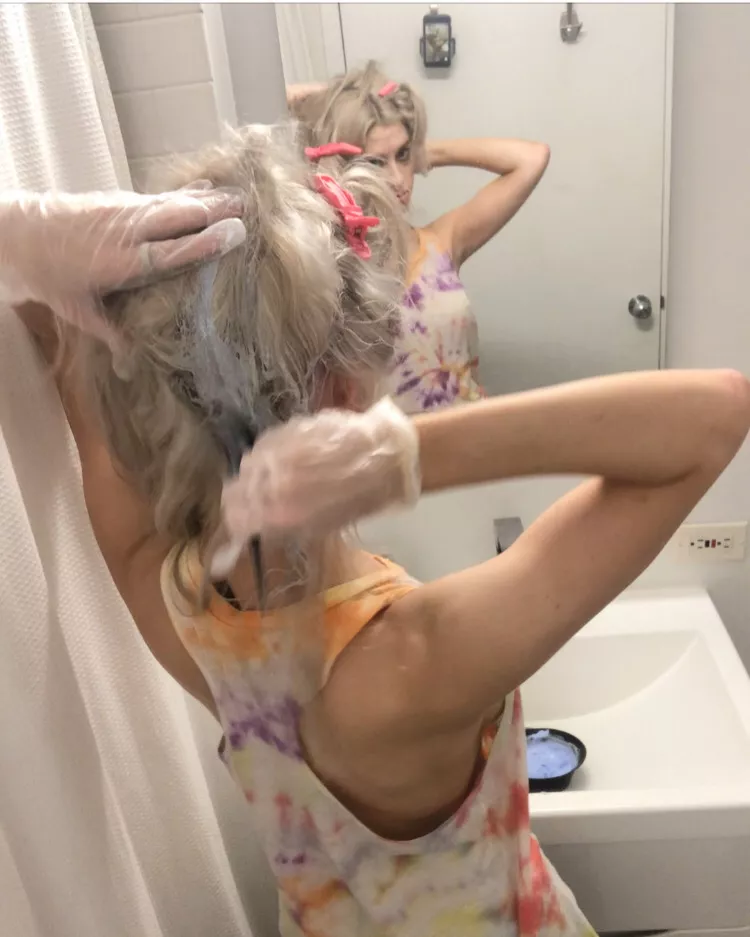
Sophie Wirt
Step 3: Apply your bleach
Still have those quarters of hair clipped up? Excellent. You’ll be working with those in a moment; but first, a few rules of thumb to keep in mind throughout the bleach application process:
Wear gloves throughout the entire process to protect your hands from irritation (chemical burns are no joke!). Make sure you’re using enough bleach and lay it on thick. “This ensures your hair is fully saturated,” Walker explains; “otherwise you could end up with a very patchy result.”Make sure you’re covering both sides of the hair. In other words, every time you “paint” a section with bleach, don’t forget to flip the section over and “paint” the back, too.
Placement: starting 1cm from the root, working your way from the back to the front “quarters.”
According to Walker, the backmost and bottommost sections of hair are generally darkest, and thus, can handle a little bit of extra processing time. For this reason, he advises applying bleach on the back “quarters” before making your way to the front. (Pro tip: the baby hairs in the front develop much more quickly and are most susceptible to damage, so save those for absolute last).
With a set of mirrors positioned in a way that allows you to see the back of your head, grab one of your two “quarters” in the back. Unclip your chosen quarter and let the hair fall loose. Then, using the tapered end of your applicator, create a horizontal part within your chosen quarter. Doing so splits the section into two manageable pieces: one that’s closest to your neck, and one that lays on top. (If you’re lucky enough to have extra-thick hair, you may need a few more horizontal layers). Since the hair closest to the neck is usually darkest, start your application here and work your way up.
Walker advises starting your bleach application about 1cm away from the scalp and leaving your roots uncovered until the very end. (Your roots develop more quickly than any other area due to heat from the scalp).
After you’ve coated the bottommost layer of your chosen back quarter, coat the remaining, overlying segment(s) until you’ve covered all of the hair within your quarter. Once you’ve completed this quarter, move to your remaining back quarter. Repeat the aforementioned “layering and painting” process.
Once you’ve covered both of your back quarters, give yourself a quick pat on the back—you’ve completed, arguably, the hardest part of this whole process. Of course, there are still two more untouched segments in the front—however, I find the front significantly easier to work with. For each of these remaining front sections, follow the same method you used for the back, continuing to leave about 1cm of root untouched.
Step 4: Bleach your roots
Time to get your roots in on the action. Walker advises mixing a fresh batch of bleach specifically for this area—“your roots are worth it!” he notes. “Once you have applied the bleach 1cm off the scalp right through to the ends, go back to the first section and start applying at the roots.”
Step 5: Use a plastic shower cap (optional)
After I’ve slathered my strands in bleach, I pop on a plastic shower cap. This keeps my hair somewhat in place; more importantly, though, the plastic traps heat and moisture, both of which keep the bleach active. “Bleach will continue to lift as long as you don’t let it dry out,” says Mesquit. Once it’s gone flaky and dry, though, it’s kind of just sitting on the hair.

Sophie Wirt
After one round of bleach
Step 6: Watch the clock and check your progress
Once you’ve covered all of your strands, including roots, with bleach, it’s a waiting game. As per the instructions on my bleach, I set a timer for 45 minutes. During that time, I check my strands every 10 minutes or so by wiping off a bit of bleach and eyeballing the hair underneath. This process is crucial for two reasons. First, it allows you to see whether the color is lifting evenly and effectively. Second, checking allows you to confirm that your hair is still intact and generally OK.
A quick caveat: while it’s important to ensure you don’t leave your bleach on for too long, it’s also important to give the lightener enough time to, well, lighten effectively. In other words, don’t jump the gun and remove the bleach too soon. I made this mistake the first time I bleached my hair. As a result, my color barely lifted; it was pure pumpkin orange—which, according to Mesquit, is indicative of premature bleach removal. To compensate, I ended up re-bleaching it that very night. Not only was this hard on my hair, but it was also a waste of precious bleach! “It’s better to let [bleach] sit in your hair for a long time than to wash it and re-apply [the same day],” Mesquit notes.
Of course, this advice is contingent upon how your hair is holding up. As well as performing the aforementioned checking, Mesquit recommends performing a quick "stretch test" to determine whether your hair can handle a bit more time under bleach. Here’s how: “Grab a strand of hair and gently tug on it; if it feels like it’s getting stretchy at all, then wash [the bleach] out immediately.” This is an indication that the bleach has leached way too much moisture from your hair—and things could get dicey very soon. However, as long as the hair feels relatively strong (not gummy or stretchy), you can leave the bleach in for a bit longer (within reason—never leave it longer than the instructions advise).
Step 7: Rinse—and rinse again
Once your timer has gone off, remove your cap, clips, etc., and hop in the shower. Turn on some lukewarm water (no temperature extremes, which can shock your freshly-bleached hair!). Then, grab a gentle shampoo (Walker and I both love Redken Bleach Recovery, $27) and begin to wash your hair as gingerly as you would a baby’s. In addition to being gentle, make sure your washing is thorough, notes Aura. “If any bleach remains on your hair, the chemicals may cause scalp burns or other damage,” she warns. To be safe, I shampoo twice. I’ve also found a scalp brush like Conair Detangle and Go Shower Massage Brush ($6), to ensure I’ve gotten any grittiness from the bleach out of my hair.
Step 8: Nourish your hair
Once you’ve shampooed adequately, apply a deep conditioner or moisturizing treatment mask. I swear by Kérastase Cicaflash Blond Absolu ($42), which is a bit of a hybrid between the two. Let the treatment sit for 10 minutes or so. Rinse. Hop out of the shower and towel-dry your hair, preferably with a supersoft microfiber towel. I love Aquis for gently pressing excess moisture from my strands and keeping friction—which can lead to breakage—to a minimum.

Sophie Wirt
Second round bleach
Step 9: Prepare for toning
If after you’ve towel-dried, you notice your hair is an alarming citrus shade, fret not! This is where toner comes in—and it makes a massive difference.
It bears repeating: to achieve a pale silver, platinum, or somewhere within that realm, you must first ensure you’ve “lifted,” your hair to a level 9 or 10—which, unless you’re a natural blonde, will take more than one round of bleaching. If you’re not there yet, simply choose a toner made for your current level. (PSA: seriously stunning silver hues exist at all levels).
For light silver: Once you’ve lifted your hair to a pale yellow (for me, it was three rounds of the aforementioned bleaching process, spaced at least a week apart), you’re ready to use a light silver/gray toner. I alternate between Wella T18 and/or Wella T11, or equal parts Redken Shades EQ O9P and 09T.
Lay out your toning supplies. This includes toner(s), peroxide developer (either 10 or 20 vol. depending on toner instructions), a fresh pair of gloves, a new (or washed) plastic mixing bowl, a new (or washed) applicator, and a shower cap if you so please.
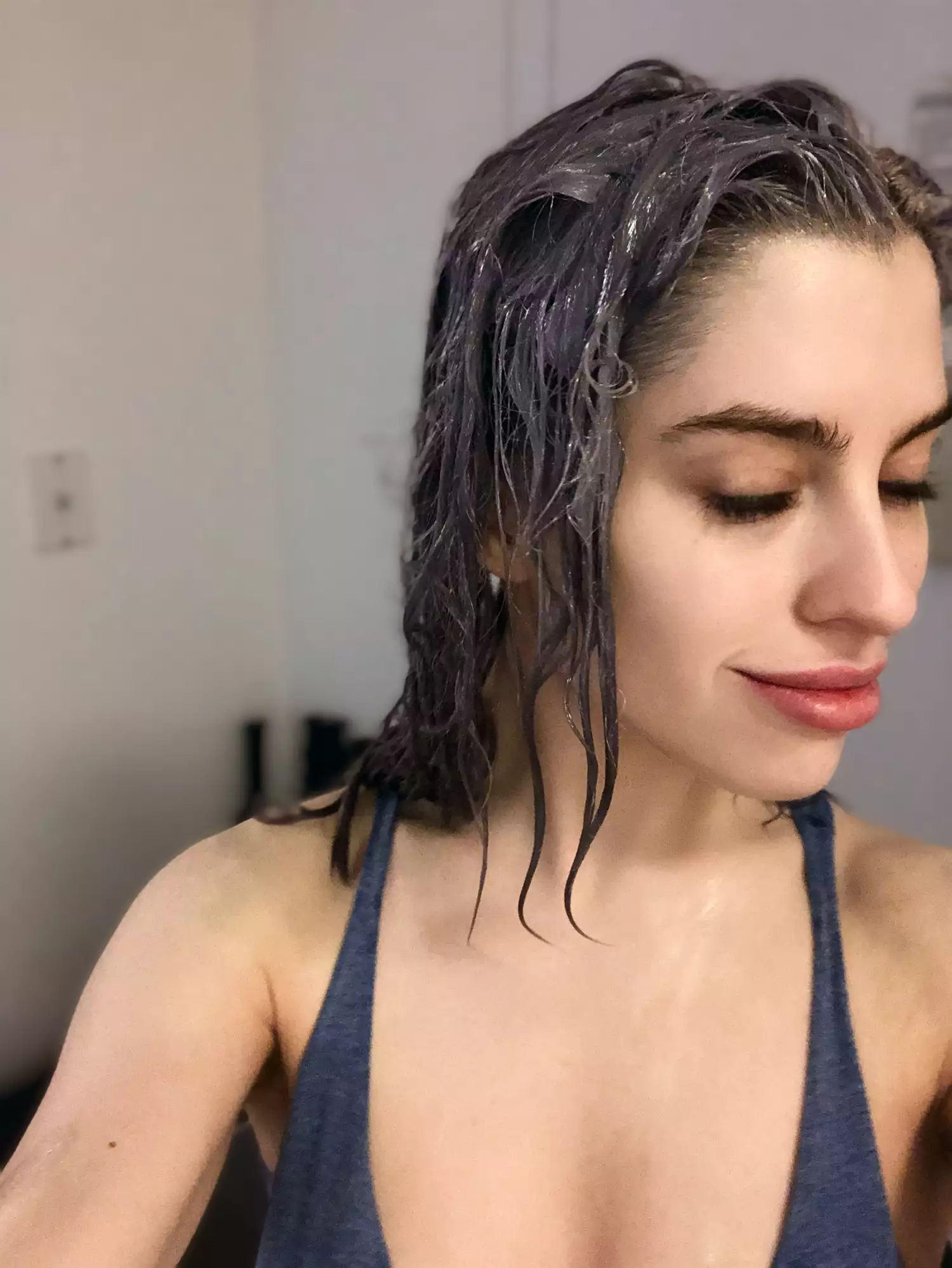
Sophie Wirt
After Applying Toner
Step 10: Mix your toner and peroxide
Similar to how you needed to add peroxide developer to your bleach blend earlier, you’ll need to mix peroxide developer with your toner, too, in order to “activate” its powers. The ratio of peroxide developer to toner formula is variable depending on the products you’re using. For the specific toners I use, it’s usually one part toner to two parts developer.
Instead of using the scoop to measure toner, I’ve found it’s easier to dump the entire bottle of toner into the plastic mixing bowl first, and then use the empty toner bottle as a measuring tool for peroxide. So, for a 1:2 ratio, I dump one bottle of toner into the bowl; then, I fill the empty bottle twice with peroxide.
Once you’ve measured and poured your toner and developer, it’s time to mix your magic potion. Put on your gloves and begin blending your concoction with your applicator brush. Mix until fully incorporated. The formula should be significantly less thick than your bleach formula was.
Step 11: Apply your toner
Luckily, applying toner is more of a low-stakes operation than applying bleach; not only is it less risky for your hair health, but toner is also more forgiving in terms of application strategy. You should certainly section and apply in a similar fashion as you did with your bleach—however, there’s a bit more leeway.
Once you’ve fully saturated your hair, loosely clip it up and/or cover it with a plastic shower cap. (If you do decide to use the shower cap method, keep in mind that your toner may develop more quickly than the instructions suggest).
Step 12: Set a timer and wait
I always set my toner timer for 20 minutes. This seems to be standard for most toners; if you’re using a different toner from the ones I mentioned, though, be sure to double check your product’s specific instructions.
Note: Any silver/gray toner I’ve used turns my hair an interesting shade of steely plum during the development process. Any unwanted purple hue should wash out in the shower, but leaving it in for longer than advised runs the risk of leaving your hair a shade of lavender for a few days until it fades.
Step 13: Wash your hair—for the final time
Once your timer is up, hop in the shower. Lather up with the same gentle shampoo you used to wash the bleach solution from your hair. Follow with a deep conditioning mask and/or restructuring treatment of choice. (Incidentally, I’d suggest investing in both product types; I tend to alternate depending on whether my hair seems to be lacking protein or moisture on any given day).
Aura says bond-building and restructuring products are “incredible for repairing hair” post-bleach. Her current favorite, K18 Peptide Masque ($75), also happens to be my go-to these days; I swear it’s the reason I’ve had very little breakage throughout my silver-hair journey. Of course, Olaplex is another option; an option Walker and a zillion other pros swear by for healing protein bonds broken in the bleaching process.

Sophie Wirt
Faded toner
Post-care
Schedule regular trimmings
If you’re feeling particularly ambitious with your newfound DIY skills, consider giving yourself a little bit of a trim to nix any fried ends that may have been exacerbated by the bleaching process. I’ve found that doing so makes my hair look significantly healthier. If you do choose to do this yourself, make sure you’re using legit hair shears, which will cut much more cleanly than the ones in your office drawer. If you’d rather leave the scissor-work to a pro (advisable!), schedule an appointment every month or so.
Stock up on purple shampoo
Your blonde friends all use it to counteract inevitable brassiness; and, as it turns out, silver-haired folks should use it, too. “Purple shampoo is very important because silver fades extremely fast,” Mesquit notes. “Using purple shampoo will help refresh some of those cool tones that are lost and keep the hair looking icy.” His choice: Wella Professionals Invigo Blonde Recharge Color Refreshing Shampoo Cool Blonde ($17). Shop more purple shampoo options here.
Deep condition daily
The week after bleaching your hair, you need to commit to deep conditioning your hair every day. Yes, daily. This will help keep your hair hydrated, and looking and feeling healthy. Were big fans of Briogeo Dont Despair, Repair! Deep Conditioning Mask ($38), thats designed to infuse your hair with moisture and strengthen your strands.
Use weekly bond repairing treatments
Bond repairing treatments help restore the integrity of your hair and keep your hair from shedding and breaking excessively. After youve bleached your hair, you want to make sure to use a bond repairing treatment, like the ever-popular combo of Olaplex Nº.0 Intensive Bond Building Treatment ($28) and Nº.3 Hair Repair Protector ($28).
Keep consistent and bleach roots
Once youve made the commitment to bleaching your hair and youre planning on rocking the color for a while, you need to make sure to bleach your roots every four to six weeks. If you let your roots grow out too long, you risk needing to bleach all of your hair all over again, which can cause damage.